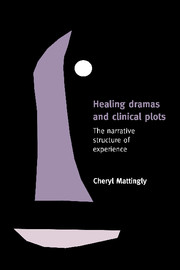Book contents
- Frontmatter
- Contents
- Preface
- Acknowledgments
- 1 Finding narrative in clinical practice
- 2 The mimetic question
- 3 The checkers game: clinical actions in quest of a narrative
- 4 Therapeutic plots
- 5 The self in narrative suspense: therapeutic plots and life stories
- 6 Some moments are more narrative than others
- 7 Therapeutic plots, healing rituals, and the creation of significant experience
- Notes
- References
- Index
Preface
Published online by Cambridge University Press: 05 June 2012
- Frontmatter
- Contents
- Preface
- Acknowledgments
- 1 Finding narrative in clinical practice
- 2 The mimetic question
- 3 The checkers game: clinical actions in quest of a narrative
- 4 Therapeutic plots
- 5 The self in narrative suspense: therapeutic plots and life stories
- 6 Some moments are more narrative than others
- 7 Therapeutic plots, healing rituals, and the creation of significant experience
- Notes
- References
- Index
Summary
This book gave me trouble. For one thing, there was the difficulty of voice. How much should I reveal of my own prejudices, my own quite individual experiences of the people I studied? I chose to write from a fairly personal perspective, especially in the first chapter and again in the third one which begins the ethnography proper. Or, more accurately, I waffled. I wrote and rewrote. Some versions were highly revealing and confessional. I especially confessed a conversion which life among occupational therapists forced upon me. In doing so, I faced the contemporary anthropologist's dilemma. I didn't want to hide in my writing or pretend to an objectivity which masked the realness of my encounters. But I didn't want to write a book about me either. I had some theories about narrative I wanted to give a central place in my account. However, when I edited myself out entirely, I confronted a different sort of problem. The verisimilitude went too. As a reader, how could you tell where you were? The solution, provided by the venerable realist in the genre of ethnography (painting pictures from a “God's eye” perspective) didn't appeal to me. If I was going to give a concrete account of the ethnographic scene, I was going to put a real narrator (me) in the scene as well. “The new ideal,” Suleiman writes about the introduction of the “I” into literary criticism, “is founded on the premise that since all writing is done by some-body for some-body, it is not merely permitted, but downright valuable, to remember who you are as you write” (1994: 2).
- Type
- Chapter
- Information
- Healing Dramas and Clinical PlotsThe Narrative Structure of Experience, pp. vii - xiPublisher: Cambridge University PressPrint publication year: 1998

